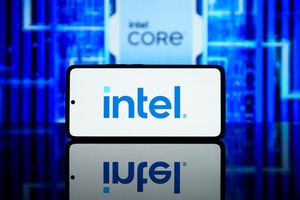
Advanced Micro Devices (NASDAQ: AMD) is making significant waves in the artificial intelligence (AI) landscape, with its stock experiencing a remarkable surge in 2025. This impressive year-to-date performance is largely attributable to the company's aggressive strategic pivot into the AI market, spearheaded by its cutting-edge Instinct MI350 and upcoming MI400 series GPUs. As AMD continues to unveil powerful hardware and expand its software ecosystem, the market is taking notice, signaling a potential shift in the highly competitive AI accelerator domain.
This concerted effort to challenge established players and capture a substantial share of the burgeoning AI infrastructure market has immediate and far-reaching implications. For investors, AMD's trajectory offers both exciting growth prospects and the inherent risks associated with high-stakes technological competition. For the broader tech industry, AMD's advancements could foster greater innovation and potentially lead to more diverse and accessible AI solutions, thereby shaping the future of AI development and deployment across various sectors.
AMD's AI Offensive: The Genesis of a Market Re-evaluation
AMD's current market momentum stems from a clear strategic commitment to becoming a dominant force in AI hardware and software. The company's year-to-date stock gains, ranging between 32% and 49% as of mid-September 2025, significantly outpace the S&P 500's (NYSEARCA: SPY) 12.4% return over the same period, underscoring investor confidence in its AI vision. This performance is anchored by robust growth in its data center segment, which has seen record server processor sales.
At the core of AMD's AI strategy is the Instinct MI300 series, particularly the MI350 series, which is a critical focus for 2025. The Instinct MI350X and MI355X GPUs are designed to deliver substantial performance improvements, with projections indicating a staggering 35x generational leap in inferencing capabilities over the MI300X and a 4x AI compute increase generation-on-generation. Notably, the MI355X is reported to outperform Nvidia's (NASDAQ: NVDA) B200 in certain AI workloads and boasts superior HBM3e memory. Looking ahead to 2026, the MI400 series, codenamed "Helios," promises further advancements, targeting real-time inference and large-scale model training crucial for the next generation of AI infrastructure.
Complementing its hardware prowess, AMD is heavily investing in its open-source ROCm software platform to cultivate a viable alternative to Nvidia's ubiquitous CUDA ecosystem. The September 2025 release of ROCm 7.0 brought significant improvements, including a roughly 3.5x uplift in inference performance on the MI300X. AMD's goal is to achieve feature parity with CUDA in popular AI frameworks by Q3 2025, thereby enhancing developer productivity and expanding its crucial developer community. These hardware and software advancements, coupled with strategic partnerships with hyperscalers like Meta Platforms (NASDAQ: META), Microsoft (NASDAQ: MSFT) for Azure, Oracle Cloud Infrastructure (NYSE: ORCL), Tesla (NASDAQ: TSLA), and OpenAI, highlight AMD's comprehensive approach to embedding itself deeply within the AI ecosystem. Furthermore, a substantial $10 billion global AI infrastructure partnership with Saudi Arabia's HUMAIN underscores the global reach and ambition of AMD's AI strategy.
Tech Titans and Shifting Sands: The Winners and Losers in the AI Race
AMD's aggressive push into AI creates a ripple effect across the technology sector, producing clear winners and posing significant challenges for established players. The most evident winner is AMD itself (NASDAQ: AMD), which has seen its stock price surge, reflecting investor optimism about its future revenue streams from AI accelerators. The company's strategic acquisitions, such as ZT Systems, designed to capitalize on the AI accelerator infrastructure market, further solidify its position. Hyperscalers and cloud providers like Microsoft (NASDAQ: MSFT), Meta Platforms (NASDAQ: META), and Oracle (NYSE: ORCL) also stand to benefit as they diversify their AI infrastructure beyond a single vendor, potentially leading to competitive pricing and more tailored solutions. These companies are already deploying AMD's MI300X and MI350 series accelerators, signaling their confidence in AMD's capabilities.
On the other side of the ledger, Nvidia (NASDAQ: NVDA) is positioned as the primary competitor and potential "loser" in terms of market share erosion, even if its overall AI revenue continues to grow. Nvidia currently holds a commanding 80-85% market share in the AI chip market, largely due to its dominant CUDA software ecosystem. While AMD's ROCm is making strides, overcoming the "CUDA moat" will be a monumental task. Intel (NASDAQ: INTC), another long-standing chip rival, also faces increased pressure as AMD expands its footprint in the high-growth data center and AI segments. Intel's efforts with its Gaudi accelerators are ongoing, but AMD's recent performance and roadmap suggest a more immediate threat to market share.
Beyond the direct competitors, developers and enterprises seeking AI solutions stand to win from increased competition. A more robust competitive landscape fosters innovation, drives down costs, and offers a wider array of specialized hardware and software options. This could accelerate AI adoption across various industries, from healthcare to financial services, where AMD is actively developing vertical-specific AI accelerators. However, companies heavily invested in a single AI hardware or software stack might face the costly challenge of re-platforming or integrating diverse solutions if AMD's offerings gain substantial traction and become industry standards.
Industry Impact and Broader Implications: Reshaping the AI Landscape
AMD's aggressive foray into the AI accelerator market is more than just a corporate strategy; it represents a significant development in the broader industry trend towards democratizing AI hardware and diversifying supply chains. For too long, the AI acceleration market has been heavily dominated by a single player, creating a bottleneck for innovation and potential vendor lock-in for enterprises. AMD's robust product roadmap, particularly with the MI350 and MI400 series, coupled with its commitment to the open-source ROCm ecosystem, provides a much-needed alternative, potentially breaking up this near-monopoly. This increased competition is expected to spur further innovation from all players, leading to more efficient, powerful, and specialized AI hardware and software solutions across the board.
The ripple effects of AMD's push extend to its competitors and partners. For Nvidia (NASDAQ: NVDA), the primary incumbent, AMD's rising challenge means sustained pressure to innovate faster and potentially adjust pricing strategies to maintain its market leadership. While Nvidia's CUDA ecosystem remains a formidable moat, AMD's progress with ROCm could gradually erode its exclusivity, forcing Nvidia to reconsider its software strategy or face a more fragmented market. For partners, particularly hyperscalers and cloud providers, AMD's advancements offer greater flexibility and negotiation power, enabling them to build more resilient and cost-effective AI infrastructures. This diversification reduces reliance on a single supplier, which is a critical consideration for national security and economic stability, especially in an era of complex geopolitical tensions.
Regulatory and policy implications are also noteworthy. The global race for AI supremacy has led to increased government scrutiny over advanced chip technology, particularly concerning export controls. U.S. restrictions on advanced AI chips to China have already impacted AMD, leading to an inventory charge and projected revenue losses from its MI308 series. While limited shipments of the MI308 to China were approved to resume, the fluid regulatory environment underscores the geopolitical sensitivity of this industry. AMD's ability to navigate these restrictions while still pursuing global market opportunities will be crucial. Historically, competition in foundational technologies like microprocessors has driven decades of innovation and economic growth; AMD's renewed vigor in AI aligns with this precedent, promising a dynamic and potentially transformative era for the industry.
What Comes Next: The Path Forward for AMD and the AI Market
The coming months and years will be pivotal for AMD's AI ambitions and the broader AI market. In the short term, the market will be closely watching the adoption rate and real-world performance benchmarks of the Instinct MI350 series. Successful deployment by key hyperscalers and positive feedback from developers leveraging the ROCm 7.0 platform will be critical indicators of AMD's ability to convert its technological advancements into tangible market share. Continued progress in closing the feature gap between ROCm and CUDA is also paramount to attracting and retaining AI developers.
Longer-term, the focus will shift to the anticipated MI400 series, codenamed "Helios," slated for 2026. This next generation of GPUs, designed for large-scale model training and real-time inference, will be a true test of AMD's ability to maintain its innovation pace and deliver products capable of powering the most demanding AI workloads. Strategic pivots could include further acquisitions in AI software or services to build out a more comprehensive AI stack, or deeper collaborations with system integrators to facilitate rack-scale AI deployments. AMD's expansion into vertical-specific AI accelerators for industries like healthcare and automotive also presents significant market opportunities, but will require tailored solutions and specialized partnerships.
Potential challenges include the continued dominance of Nvidia's (NASDAQ: NVDA) CUDA ecosystem, which represents a high barrier to entry for many developers, and the ever-present threat of geopolitical tensions impacting export markets. Furthermore, the intense capital expenditure required for AI-driven research and development could pressure AMD's margins, though profitability is expected to accelerate with increased AI revenue. Investors should watch for consistent revenue growth from the data center segment, strong analyst ratings, and any new strategic partnerships or customer wins that underscore AMD's growing influence in the AI domain. The emergence of new AI architectures or computing paradigms could also present unforeseen opportunities or disrupt current strategies, requiring rapid adaptation from all market players.
Conclusion: AMD's Enduring Impact on the AI Frontier
AMD's aggressive push into the artificial intelligence market in 2025 marks a transformative period for the company and the broader technology industry. Its impressive year-to-date stock gains, fueled by the promising Instinct MI350 series and the eagerly awaited MI400 GPUs, underscore a clear message: AMD (NASDAQ: AMD) is a formidable contender in the AI accelerator race. The strategic investments in its open-source ROCm software ecosystem and robust partnerships with major hyperscalers are laying the groundwork for a more diversified and competitive AI hardware landscape, moving beyond a single-vendor paradigm.
Moving forward, the market will intently monitor AMD's execution, particularly the adoption rates of its MI350 series and the continued evolution of ROCm. While the challenge posed by Nvidia's (NASDAQ: NVDA) established CUDA ecosystem and ongoing geopolitical complexities remain significant, AMD's sustained innovation, strategic alliances, and expanding product portfolio suggest a positive trajectory. The company's commitment to delivering high-performance, cost-effective AI solutions is poised to accelerate AI development and deployment across various sectors, benefiting not just enterprises and developers but ultimately the global economy.
Investors should maintain a vigilant eye on AMD's data center revenue growth, the market reception of its next-generation products, and any new strategic partnerships or customer wins that underscore AMD's growing influence in the AI domain. The company's journey exemplifies the dynamic nature of technological innovation, promising a future where competition drives progress and expands the frontiers of what AI can achieve.






